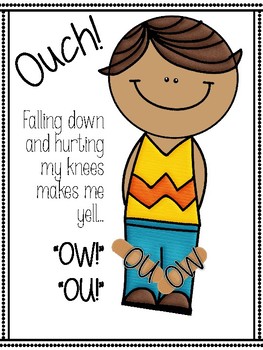ow diphthong anchor chart practice click file print by oh so random
Table of Contents
Table of Contents
Do you struggle with teaching phonics to young learners? Are you searching for an engaging way to teach the ou ow vowel dipthongs? Look no further than the ou ow anchor chart!
Teaching phonics can be a daunting task for any educator. It can be especially tricky to teach vowel dipthongs like ou ow. Many students struggle to differentiate between these two similar sounds, leading to frustration and confusion. But fear not, the ou ow anchor chart is here to save the day!
The ou ow anchor chart is designed to help students visually understand the differences between these two sounds. By providing clear examples and memorable images, students are more likely to retain the information and correctly apply it to their reading and writing.
In summary, the ou ow anchor chart is a powerful tool for any educator looking to teach young learners the intricacies of phonics. By providing visual aids and clear examples, students will be better equipped to differentiate between these two sounds and confidently apply their knowledge to reading and writing tasks.
The Target of the Ou Ow Anchor Chart
The ou ow anchor chart targets young learners who are learning to differentiate between these two vowel dipthongs. It is especially useful for students in first grade and beyond who are working on building foundational phonics skills.
As a first-grade teacher myself, I have seen the benefits of using the ou ow anchor chart firsthand. My students have been able to easily identify the differences between these two sounds and have grown in their confidence and ability to apply this knowledge to their reading and writing.
The Success of the Ou Ow Anchor Chart in the Classroom
One teaching approach I have found to be incredibly effective is pairing the ou ow anchor chart with interactive activities and games. For example, I like to play a game called “Ou vs. Ow” where students must listen to a word and identify if it contains the ou or ow sound. This fun and engaging activity helps to reinforce the information learned on the anchor chart and keeps students interested and motivated.
 ### The Benefits of Using an Anchor Chart for Teaching Phonics
### The Benefits of Using an Anchor Chart for Teaching Phonics
Anchor charts are a fantastic teaching tool for a variety of subjects, and phonics is no exception. An anchor chart provides a clear and concise visual aid that can help students to better understand complex concepts. It also serves as a reference point that students can revisit throughout the learning process, reinforcing their understanding and retention of the material.
 #### Tips for Making an Effective Ou Ow Anchor Chart
#### Tips for Making an Effective Ou Ow Anchor Chart
When creating an ou ow anchor chart, it’s important to keep it visually engaging and easy to understand. Use bright colors and eye-catching images to draw students’ attention. Be sure to provide clear examples of words that contain each sound, and encourage students to add their own examples as they encounter them in their reading and writing.
Frequently Asked Questions
1. How can I make sure my students are retaining the information on the ou ow anchor chart?
One great way to reinforce the material is through interactive games and activities. Try playing a game of “Ou vs. Ow” or challenging students to identify ou ow words in their reading. You can also provide incentives for correct answers or offer praise for progress and improvement.
2. What age group is the ou ow anchor chart best suited for?
The ou ow anchor chart is best suited for students in early elementary school, particularly those in first grade and beyond who are building foundational phonics skills. However, it can be adapted for use with older or younger students as well.
3. Are there any common mistakes to watch out for when using the ou ow anchor chart?
One common mistake is assuming that all words containing “ou” or “ow” are pronounced the same way. While some words like “cloud” and “cow” have the same pronunciation, others like “out” and “snow” have different sounds.
4. How can I use the ou ow anchor chart in conjunction with other teaching strategies?
The ou ow anchor chart works well in conjunction with other teaching strategies like interactive games and activities, read-alouds, and guided reading. Incorporating a variety of teaching approaches will help to reinforce the material and provide multiple opportunities for students to practice and apply their knowledge.
Conclusion
The ou ow anchor chart is a powerful tool for any educator looking to teach young learners the intricacies of phonics. With its clear examples and engaging visual aids, students will be better equipped to differentiate between these two sounds and confidently apply their knowledge to reading and writing tasks. By incorporating interactive games and activities and other teaching strategies, educators can ensure that their students retain the material and continue to grow in their phonics skills.
Gallery
-ow Diphthong Anchor Chart & Practice Click File, Print By Oh So Random

Photo Credit by: bing.com / chart diphthong ow anchor practice file print click
OU OW Vowel Dipthongs Anchor Chart By Hooray For Learning | TpT

Photo Credit by: bing.com / ow dipthongs vowel hooray
OU OW Vowel Dipthongs Anchor Chart By Hooray For Learning | TpT

Photo Credit by: bing.com / chart ow ou anchor vowel dipthongs teacherspayteachers charts grade apply students
Pin By Kristin Soelberg On School Stuff!! | Anchor Charts First Grade

Photo Credit by: bing.com / phonics ow oa jolly ec0 spelling nael invitationurn
Ow/ou Anchor Chart | Teaching Phonics, First Grade Phonics, English Phonics

Photo Credit by: bing.com / ow ou anchor chart phonics charts teaching rules vowel sound grade sounds jolly reading first worksheets spelling ak0 cache choose





